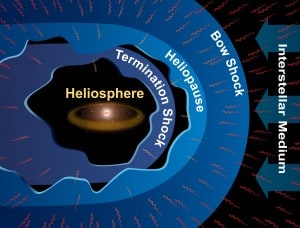

Credit: Southwest Research Institute
But in the nearly two years since that historic announcement, and despite subsequent observations backing it up, uncertainty about whether Voyager 1 really crossed the threshold continues. There are some scientists who say that the spacecraft is still within the heliosphere—the region of space dominated by the Sun and its wind of energetic particles—and has not yet reached the space between the stars.
Now, two Voyager team scientists have developed a test that they say could prove once and for all if Voyager 1 has crossed the boundary. The new test is outlined in a study accepted for publication in Geophysical Research Letters, a journal of the American Geophysical Union.
The scientists predict that, in the next two years, Voyager 1 will cross the “current sheet”—the sprawling surface within the heliosphere where the polarity of the sun’s magnetic field changes from plus to minus. The spacecraft will detect a reversal in the magnetic field, proving that it is still within the heliosphere. But, if the magnetic field reversal doesn’t happen in the next year or two as expected, that is confirmation that Voyager 1 has already passed into interstellar space.
George Gloeckler, a professor in atmospheric, oceanic and space sciences at the University of Michigan in Ann Arbor and lead author of the study, who has worked on the Voyager mission since 1972, has been a vocal opponent of the view that Voyager 1 has already entered interstellar space. He said that, although the spacecraft has observed many of the signs indicating it may have reached interstellar space (such as cosmic rays), Voyager 1 did not see a change in magnetic field that many were expecting.
“This controversy will continue until it is resolved by measurements,” Gloeckler said.
If the new prediction is right, “this will be the highlight of my life,” he said. “There is nothing more gratifying than when you have a vision or an idea and you make a prediction and it comes true.”
The twin Voyager spacecraft, Voyager 1 and Voyager 2, were launched in 1977 to study Jupiter and Saturn. The mission has since been extended to explore the outermost limits of the Sun’s influence and beyond. Voyager 2, which also flew by Uranus and Neptune, is on its way to interstellar space.
Alan Cummings, a senior research scientist at Caltech and a co-investigator on the Voyager mission, believes Voyager 1 has most likely crossed into interstellar space, but he said there is a possibility that Gloeckler and Fisk are right and the spacecraft is still in the heliosphere. He said that if Voyager 1 experiences a current sheet crossing like the one being proposed in the new study, it could also mean that the heliosphere is expanding and crossed the spacecraft again.
“If the magnetic field had cooperated, I don’t think we’d be having this discussion,” Cummings said. “This is a puzzle.”
Ed Stone of Caltech, who is NASA’s Voyager Project Scientist, added that “It is the nature of the scientific process that alternative theories are developed in order to account for new observations. This paper differs from other models of the solar wind and the heliosphere and is among the new models that the Voyager team will be studying as more data are acquired by Voyager.”


Be the first to comment